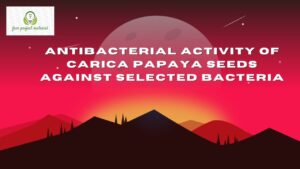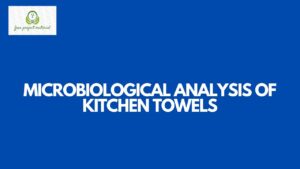ABSTRACT
The aim of this study was to examine the antimicrobial resistance pattern of lactose fermenters Enterobacteriaceae isolated from eggroll within Ikot Ekpene metropolis. The study utilized standard aseptical methods in analyzing the samples. The result of the study revealed the following; total bacterial contents obtained revealed that sample 6 had the highest colony count of 6.8×104 cfu/g while sample 1 had the least with 2.9×104 cfu/g. Frequency distribution and the percentage occurrence of the bacteria isolates obtained from the samples revealed that Pseudomonas sp had the highest percentage occurrence (30.2%) while Salmonella sp had the least percentage occurrence (7.5%). The morphological and biochemical characteristics of the bacteria isolated from the samples revealed the following; Shigella sp, Klebsiella sp, Enterobacter sp, Salmonella sp, Pseudomonas sp and Proteus sp. Salmonella sp showed the highest resistance to the antibiotics followed by Proteus sp. The bacterial contamination of the samples were found to be higher than the 103 cfu/g permissible limit set by WHO for ready-to-eat food. This high resistance of the lactose fermenters Enterobacteriaceae is of public concern as this could result in epidemic overtime if not brought under control. Personal hygiene and measures for proper handling of baked foods are advised to reduce the spread of drug-resistant bacteria in the metropolis
TABLE OF CONTENTS
Tittle Page – – – – – – – – i
Declaration – – – – – – – – – ii
Certification – – – – – – – – iii
Dedication – – – – – – – – – iv
Acknowledgement – – – – – – – – v
Abstract – – – – – – – – – vi
Table of Contents – – – – – – – – vii
CHAPTER ONE
1.0 INTRODUCTION – – – – – – 1
1.1 Aim and objective of the study – – – – – 3
CHAPTER TWO
2.0 LITERATURE REVIEW – – – – – 5
2.1 Enterobacteriaceae – – – – – – 6
2.2 Morphology and Metabolism of Enterobacteriaceae – 7
2.3 Antibiotic Resistance of Enterobacteriaceae – – 8
2.4 Enterobacteriaceae and their role of indicator and
index organisms in foods – – – – – – 9
2.5 Enterobacteriaceae in food spoilage – – – – 10
2.6 Lactose Fermenters Enterobacteriaceae as food
borne Pathogens – – – – – – – 13
2.6.1 Description of lactose Fermenters – – – – 13
2.7 Mechanism of antibiotic resistance in isolates – – 14
2.8 Factors that influencer the growth of
lactose fermenter Enterobacteriaceae – – – – 15
CHAPTER THREE
3.0 MATERIALS AND METHOD
3.1 Sample Collection – – – – – – – 18
3.1 Method – – – – – – – – 18
3.1.1 Sample Collection – – – – – – – 18
3.1.2 Sterilization of Glass wares – – – – – 18
3.1.3 Preparation and Sterilization of Media – – – – 19
3.1.4 Sample Preparation – – – – – – 19
3.1.5 Inoculation and Incubation – – – – – 19
3.1.6 Enumeration of the total Microbial count – – – 20
3.1.7 Purification of Bacterial Isolates – – – – – 20
3.2 Antibiotic Sensitivity Test – – – – – – 20
CHAPTER FOUR
4.0 RESULT AND DISCUSSION
4.1 Result – – – – – – – – – 22
4.2 Discussion – – – – – – – – 29
CHAPTER FIVE
5.0 CONCLUSION AND RECOMMENDATION
5.1 Conclusion – – – – – – – 34
5.2 Recommendations – – – – – – 35
References
CHAPTER ONE
1.0 INTRODUCTION
The family Enterobacteriaceae comprises a large group of gram-negative non-spore-forming bacteria typically 1-5µm in length. They are facultative anaerobes and with the exception of Saccharobacter fermentans and some strain of Yarsinia and Erwinia, they share the ability to reduce nitrate (Hope et al., 2020). These bacteria are generally motile by Peritrichous flagella except for Shigella and Tatumella and some other non-motile members of this family.
For example, Salmonella are typically motile notable exceptions being the Salmonella serotypes Pullorum and Gallinarum. A common feature of the Enterobacteriaceae, which helps to differentiate them from other closely related bacteria, is the lack of cytochrome C Oxidase, although there are exceptions such as Plesinomonas spp. Enterobacteriaceae ferment a variety of carbohydrates but their ability to produce acid and gas from the fermentation of D-glucose is one characteristic that remains an important diagnostic property and is commonly used as a basis for their detection and enumeration (Rick et al., 2001). Some members of the Enterobacteriaceae (e,g. Enterobacter spp, Escherichia coli, Citrobacter spp and Klebsiella spp.) can be recognized using methods that exploit their ability to ferment lactose rapidly (usually within 24-48 hrs) producing acid and gas. These are collectively termed coliform bacteria and are often used as (faecal) indicator organisms by the food and water industry because their normal habitat is the gastrointestinal tract of mammals, birds etc. However, unlike the Enterobacteriaceae family, this is not a well-defined taxonomic group (Musgrove et al., 2008).
Member of the Enterobacteriaceae are widely distributed, although strains of some species are harmless (Fewrell, 2001). Vegetable contamination can arise to due to the treatment of soil with organic fertilizer such as sewage sludge and irrigation water as well as from the ability of pathogens to persist and proliferate in vegetables (Heaton and Jones, 2008). Escherichia coli are one of the most common normal floras (N.F) of the gastrointestinal tract of poultry and humans. It is also present in other animals but may become pathogenic to both poultry and humans (Brooks et al., 2010).
Pathogenic Gram-negative bacteria are treated with antibiotics and the efficient agents are fluoroquinolones, beta-lactams and aminoglycosides (Kocsis and Szabo, 2013). Resistant strain from the poultry gut readily contaminate poultry carcass and when consumed, they alter or affect the endogenous normal flora of humans (Van et al., 2021). Gene transfer occurs primarily in vivo between gastrointestinal tract bacteria (GT) and pathogenic bacteria because identical resistant genes are present in diverse bacterial species from different host (Scott, 2022).
1.1 Aim and Objective of the Study
Aim of the study
The aim of this study is to analyze for the antimicrobial resistant pattern of lactose fermenters Enterobacteria isolated from egg roll sold within Akwa Ibom State Polytechnic.
The Objectives are:
- To analyze the egg-roll using standard microbiological methods.
- To use specific media to isolate lactose fermenter from the egg-rolls
- To carry out antibiotic susceptibility test on the isolated lactose fermenters
To determine the resistance pattern of the isolated to the available antibiotics.


